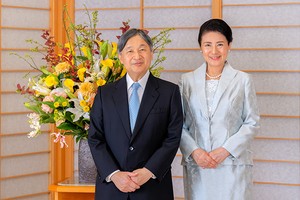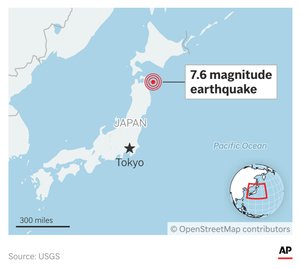By ASAKO MIYASAKA/ Senior Staff Writer
January 7, 2023 at 07:00 JST
An 11-year-old boy in Hiroshima Prefecture who had refused to go to school because he found the environment too harsh has found a way to return to the fold and continue with his education.
He is one of a growing number of chronically absent students with social anxiety who are finding their academic salvation in a virtual world known as the metaverse--a buzzword for an online graphical space where users can meet and interact with each other through personalized avatars that serve as their virtual alter egos.
The fifth-grader accesses it through an online platform called “room-K,” a learning support center that works like a chat room but looks more like a role-playing videogame.
It is run by a nonprofit called Katariba, which offers support services for students just like him who are at risk of falling through the cracks in the education system.
“It doesn’t feel like 'studying' very much, but I enjoy learning there,” he said.
The boy, who does not want his identity revealed, had started saying that he hates school halfway through his first year at elementary school because the teachers would criticize and scold him unless he sat still and did what he was told.
Whenever he sees written words, he becomes hyper focused on reading and becomes oblivious to everything else—which can be a big problem at school.
Once a teacher gave him a newspaper for a class cut-and-paste activity, but he became so absorbed by the articles that he forgot to do the assignment.
He was chastised by his teachers every day because of incidents like this.
Then, just as he felt he was running out of energy, the COVID-19 pandemic hit, and he nearly dropped out around the end of his second year of elementary school.
There was no “free school” in his neighborhood for “futoko” students like him who refuse to go to school. So-called free schools are private-run educational organizations that accept students struggling with truancy.
He enrolled at a place where children can engage in activities like crafts several times a week, but his classmates are always different, so he has been unable to make friends in his age group.
But then last fall, he discovered room-K, a virtual metaverse space designed to look like a school campus, complete with a classroom, a living room, and a game area. It also has a garden with a pond where students can stroll, hunt for treasure or play tag with others.
“I can casually chat and play with students from across the country in the metaverse,” he said. “That’s what I find very good about it. That makes me feel like I want to meet them in the real world.”
A typical day for the fifth-grader plays out a little like this Tuesday in early November.
He opened his laptop at 9 a.m. and accessed room-K. It had been a while since the last time he did so on a Tuesday. He was happy to spot his friend, who studied with him there before.
He participated in a “club activity” until 9:30 a.m., where he trained his brain by trying to solve a three-dimensional puzzle with several other students.
After clearing his head, he exited the virtual space and turned to studying at his desk in the real world.
One hour later, he accessed the metaverse again.
This time, he chose mathematics from a list of subjects and programs that included history and science and joined a 45-minute virtual lesson on the subject.
After lunch, he joined “reading time,” a book club in the metaverse, with two other elementary school and junior high school students.
The boy read a biography of Ryoma Sakamoto (1836-1867), a famous samurai at the end of the Edo Period (1603-1867), while the other students read a novel and a story written in English.
The boy’s mother said with a relieved look on her face that the experience has been good for her son’s development.
“My son used to be too conscious about what other people might think about him and clam up as a result,” she said. “But this place gives him a sense of security that he can always casually pop in and be accepted by people who would say, ‘Hi, long time, no see!’
“No one scolds him, even if he is restless. And people listen carefully to whatever he says. That has made my son accept what other students say for what they are, too.”
The boy found that the same students more or less gather there on the same days of the week.
Some only come to room-K to chat with other students. But others become so engaged that they even remain there to play together once their program ends.
He also likes how each student in room-K has an adult who mentors them, almost as if they are their older brothers or sisters.
Students have a weekly strategy meeting there with their mentors where they prepare their own syllabus. Their plans are designed so they can make small accomplishments, again and again, making them want to continue learning.
Recently, he has been visiting another place called "School S” three days a week.
It is a service run by the Hiroshima prefectural government to support futoko students both in physical and online spaces.
He now accesses room-K about four times a week, and even sometimes goes to his regular school after school hours.
And now, some of the students he was using room-K with have returned to the schools they had stopped attending, he said.
“It looks like he’s enjoying his life now, so what he will do in the future is up to him,” his mother said.

Room-K was launched by Katariba in 2021 to give futoko students a dedicated online space to meet and learn. Now, more than a year later, educators increasingly see it as a successful way to help students struggling with truancy.
Some schools even view room-K attendance as the same as going to class.
Students who live in areas that have an agreement with Katariba can use room-K.
So far, seven areas, including Hiroshima Prefecture and Toda in Saitama Prefecture, have signed an agreement like this.
Parents and local officials are also watching room-K with great interest.
Around 200 people attended an online event on Nov. 9 organized by Katariba on how schools can support futoko students through the metaverse platform.
The Toda city government started collaborating with Katariba last summer.
It had its own endeavors to support futoko students, such as providing a support room and a counseling room within its schools and establishing dedicated education support centers.
But officials soon found some futoko students would not come to any of these places.
Tsutomu Togasaki, the chair of Toda’s board of education, believes that the metaverse is a good means for communicating with students struggling with going to school.
“Considering social trends and other things, there is no doubt that communications technology will be more familiar to us at work, home and school,” he said. “The right support methods vary from student to student. But so long as there are students who only engage in support through the metaverse, we will continue this kind of support.”
And Toda is not the only place using the metaverse to help kids at risk of dropping out.
Kumamoto city began using computer devices in December that every student has been given under the government’s “GIGA school initiative” so they can access the metaverse run by NTT Communications Corp.
Under the GIGA school initiative launched by the education ministry last year, every student in public elementary or junior high schools is provided with one computer device for learning.
Following the powerful earthquakes there in 2016, the Kumamoto city government started providing students in the city with computer devices so they can learn at home.
Once the COVID-19 pandemic began, elementary schools and junior high schools in the city quickly started online lessons.
In spring last year, the city government started providing online support for futoko elementary school and junior high school students.
Many students were camera shy at first. Some started showing dolls instead of their faces when attending their online lessons because they did not want to be seen.
This practice quickly became popular among students who took part in the online lessons, with more of them using their favorite fictional characters to represent them.
This had encouraged city government officials to turn to the metaverse to support futoko students.
“Experiencing school life in the virtual world helps students with their self-esteem, motivates them to learn and also enables them to better communicate,” said Hiromichi Endo, chair of the Kumamoto board of education.
The Aichi Prefecture board of education is also considering using the metaverse for students at prefectural-run Nisshin High School starting in fiscal 2026.
The board has been promoting its policy of integrating public junior high and high schools.
Nisshin High School is set to become an integrated school that accepts futoko students under the board’s policy.
“It’s good that support for futoko students is expanding in various ways,” an education ministry official said. “We hope that each student will be able to choose a way to learn that suits them.”




















A peek through the music industry’s curtain at the producers who harnessed social media to help their idols go global.
A series based on diplomatic documents declassified by Japan’s Foreign Ministry
Here is a collection of first-hand accounts by “hibakusha” atomic bomb survivors.
Cooking experts, chefs and others involved in the field of food introduce their special recipes intertwined with their paths in life.
A series about Japanese-Americans and their memories of World War II